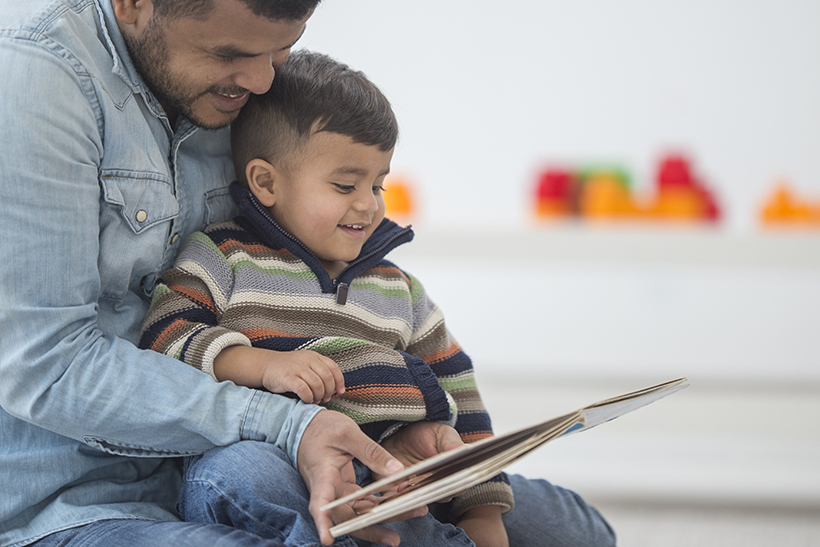This blog post was written by NCTE member Aspen Mock.
Oral tradition and storytelling were just a normal part of spending my summers at my grandparents’ home. My grandfather Mac, with a sparkle in his eyes and his quick smile, was the quintessential Irishman—a weaver of original stories and tales, some true and some new. When we’d dialogue with him, my grandparents’ little kitchen, shrouded with the regularity of everyday life, turned into a colorful world filled with dramatic tales of love, mischief, and bravery.
Having a family culture that embraced storytelling developed and shaped me as a person and informed my education. Whenever a project at school had a narrative component, I had not only a great repository of family tales to share, but a home support system of people interested in and proud of what I had shared with my school community.
As educators, we can collaborate with our students and their families to create a story canon by creating, capturing, and preserving their own original stories, both fiction and nonfiction. Supporting and cultivating family literacy is the cornerstone of our shared school-home culture. Storytelling both reflects and shapes the culture in which it exists. Schools that can form literacy-based partnerships with families in their community strengthen and enrich their own cultural capacity and ability to serve their student population.
Here are some ways we can nurture family literacy, whether at home or at school:
Supporting Storytelling: Tips for Educators
- Guide students to choose a form of storytelling and a medium through which it will be preserved and shared.
- Create partnerships with families and various organizations to support and celebrate family literacy.
- Use best-practice techniques to develop and celebrate the narratives.
- Brainstorm about and give a mouthpiece to the untold stories in your region.
- Provide tutorials on how to use educational technology to capture and preserve family tales. Consider websites and apps (two examples are Storybird.com and BookCreator.com) that can help students and families create books out of their family literacy experiences.
Storytelling Tips for Families
An underused medium, oral storytelling offers rich opportunities for family literacy development. It encourages a literate family lifestyle by building a collection of stories celebrating shared experiences and providing topics for conversations and discussions. Tips for families include:
- Make it an “experience.” Build a memorable experience and detail practical ways to schedule storytelling time. For example, in my family we tell stories during dinner, which my 6-year old daughter calls “Dinner Stories.” You can tell stories whenever you have to wait somewhere, and can even have themed nights for storytelling based on holidays, seasons, or current events. Plan some and improvise others; it’s good to have a mix of both!
- Co-construction. Take turns as speaker and listener; build the story collaboratively. Encourage the use of detail, adding descriptive adjectives and vivid verbs as you journey through your tales. Asking questions throughout the narrative can be a helpful way to clarify, collaborate and build your stories in real time.
- Preserve your “work.” Play the scribe or use technology to record your stories, making paper or digital versions to preserve them. Typing out or recording a story as it is told and sharing it with other family members on social media can be great fun and involve others, and provides a built-in audience for storytelling. (One tech-savvy option is capturing a visual or digital story through a program like Adobe Spark.) Stores are meant to be retold—remember to revisit your stories and tell them again and again!
- There’s an app for that! Search out apps that will help you incorporate literacy activities into your daily family life. Your children’s teachers and librarians may have recommendations. For example, an app like ReadyRosie lets you search tutorial videos and implement family literacy activities depending on the ages and stages of your children, from infancy and up. When my eldest daughter was learning her colors, we wrote original poems together; she still joyfully revisits these poems in her journal.
My family literacy experiences carried over into adulthood; during my first year of college, I transcribed our family tales into a collection entitled “Griosach,” an Irish word meaning “burning embers.” The tales my family grew up with, time spent with my grandfather Mac, and the warmth and imaginative elements of that little kitchen, are now preserved and shared as part of our family literacy tradition.
I think of “Griosach” as a metaphor for the power of storytelling; if we fan the smoldering embers of our stories, we ignite the light and power of family literacy in ourselves and our community.

Aspen B. Mock currently teaches Composition 9, Honors Composition 9 & AP Literature & Composition 12 at Forest Hills Jr.-Sr. High School in Sidman, Pennsylvania. She is currently serving as a KQED Media Literacy Innovator. Her educational philosophy and approach is to provide a creative, collaborative educational environment and writing community with a focus on 21st century skills, service-learning and critical thinking. Follow her on Twitter @AB_Mock or her blog www.aleatoryimaginarium.com.

